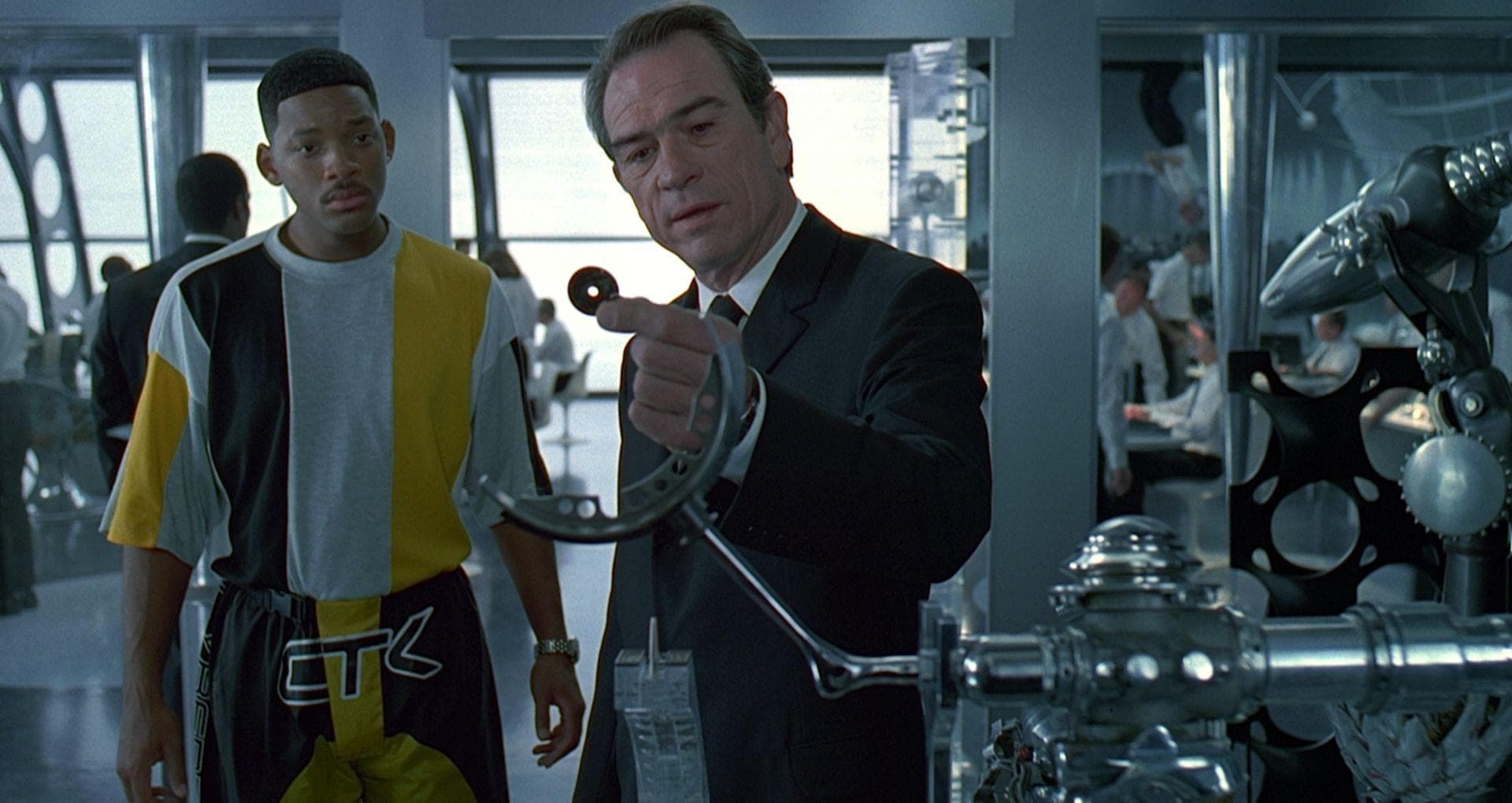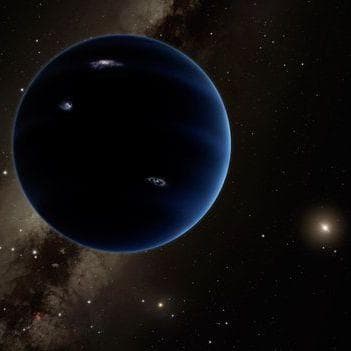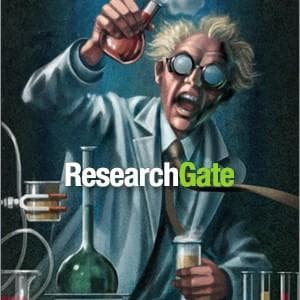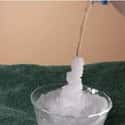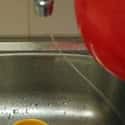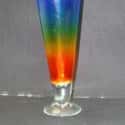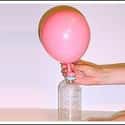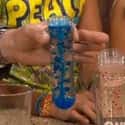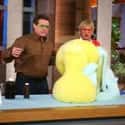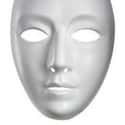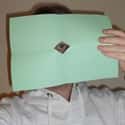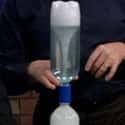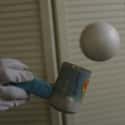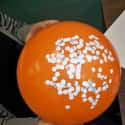-
(#1) Hypercooling
What You Need:
-A metal bucket
-32 oz. of table salt
-6 16oz bottled water
-2 bags of crushed ice and water
-Thermometer (optional)
-PatienceWhat You Do:
-Take three to six (sealed) plastic bottles of mineral water.-Place them in your bucket and pour in a bag of ice; add water so that the ice becomes slushy.
-The lids of your water bottles should be sticking out the top of the ice/water mixture so you can handle them without freezing your fingers. Make sure they are evenly spaced in the bucket.
-Pour in the salt, use 26 oz of salt if you only use three bottles and 32 oz for six bottles.
-If you have a thermometer, place it in the bucket.
-Wait 35-45 minutes, but keep checking on the bottles, turn them gently to insure that they cool evenly.
-When time is up, you'll see a thin layer of ice on the outside of your metal bucket.
-Take the bottle out and turn the bottle on its side. Swing it lightly back and then BANG it against a wall. Watch as the water slowly changes color and turns to ice.
Alternate Ending:
Take a glass bowl and place a few ice cubes inside. Gently open the lid of your super cooled bottle of water. Slowly pour it onto the ice in the bowl. The liquid water should turn to ice as soon as it makes contact with ice cubes in the bowl. This means that you should be able to produce a tower of ice as you keep pouring.The Science:
-Pouring liquid water that lands as solid ice – this works because of the ice cubes already in the bowl. One of the best nucleation sites that you can use to form ice crystals, is other ice crystals.
-When the bottles are super cooled, they are ready for a freezing catalyst. One theory is that the banging creates microscopic air bubbles near the surface in the bottles, and these bubbles act as the impurity/nucleation site. -
(#2) Fun With Physics
What You Need:
For Experiment 1:
-Empty Jam Jar
-Rice
-PencilExperiment 2:
-Balloon or comb
-FaucetExperiment 3:
-Tennisball
-BasketballWhat You Do:
Experiment 1:Sticky Rice: Get a clean jam jar. Fill to the top with rice. Hold the jar firmly with one hand, push a pencil right to the bottom. Pull the pencil up slowly but not all the way out. Then push it back down again. If the rice level starts to drop, top off the rice. Eventually, the rice will compact around your pencil, and you will be able to lift the whole jar with the pencil. When this happens, the friction between the pencil and rice is so great that you cannot easily pull the pencil out!
The Science:
Every time you plunge the pencil into the rice, you are compressing the grains and making them pack more tightly together. The air gaps decrease in size and the rice grains rub against each other more. They can't move as freely and start to arrange in a pattern that doesn't change. The rice you could previously pour like a liquid becomes solid.With more grains of rice pressing onto the pencil, and each one of those more tightly packed in, the friction between the pencil and the rice increases. If the friction force between the rice and pencil equals the combined weight force of the rice and the container, then the balance of forces means the pencil is held in place. For the jar to lift as well, friction between its inside walls and the rice must also increase. This proves that the rice has moved and compacted, even where it wasn't disturbed it with the pencil.
Experiment 2:Bend water with static electricity: Blow up a balloon or use a comb and rub it against your head to build up a static charge. Do this for several minutes to really get a decent charge. Then, turn a tap on: it should be on enough for a steady but slow stream of water to come out, not just drips. Bring the balloon close to the stream of water and observe what happens!
The Science:
When two objects are rubbed against each other, some of the electrons from one object jump to the other. The object that gains electrons becomes more negatively charged; the one that loses electrons becomes more positively charged. The opposite charges attract each other where you can actually see it.Experiment 3:
Super bouncing: Do this outdoors with a lot of space. Grab a tennis ball. Drop it on the ground and see how high it bounces. Now grab a basketball. Drop it on the ground and see how high it bounces. Now put the tennis ball on top of the basketball; support the basketball with one hand and the tennis ball with the other. Drop your two balls at exactly the same time.
The Science:
When you drop the two balls together, they will separate just a little bit. The basketball will hit the ground first, and will rebound. As it is on the way up, it hits the tennis ball, which is still on its way down. So you have a head-on collision, between balls of very different masses. When this happens, a lot of the energy of the basketball gets transferred to the tennis ball, so watch out as the tennis will end up bouncing very high. -
(#3) Rainbow Glass
What You Need:
-5 glasses
-Sugar
-Water
-Food coloring
-Tablespoon
-Patience and a steady handWhat You Do:
Line up the glasses and put three tablespoons of water into the first four glasses. Add one tablespoon of sugar to Glass #1, two to Glass #2, three to Glass #3, four to Glass #4. Stir thoroughly to dissolve the sugar. Now add a different color of food coloring to each glass. Pour 1/4 of Glass #4's contents into Glass #5.This gets a bit tricky, and you'll need some practice. You must pour the next layer (Glass #3) so gently that it doesn't mix with the first layer. You can put a teaspoon just above the first layer and pour the mixture gently over the back of the spoon to minimize splash. The more slowly you do this, the better the results. When you have filled the glass to about the same width as the last layer, repeat with Glass #2, and then with Glass #1.
The Science:
The different amounts of sugar in water create different densities of water. As you are layering them with the heaviest at the bottom, the different layers will 'sit' on top of each other. Eventually, due to particle dynamics, the layers will mix. The greater the difference in density, the longer the effect lasts. Unlike water and oil, however, once you mix the layers, they will not settle back. -
(#4) Self Inflating Balloon
What You Need:
-A used, washed carbonated drink bottle (lid not required)
-Latex balloon (thinner is better)
-Elastic band
-Measuring jug
-Yeast
-Sugar
-WaterWhat You Do:
The Science:
Place 2 teaspoons of yeast, 1 teaspoon of sugar and one cup of water into the bottle. Put the balloon over the top of the bottle and secure with the elastic band. Walk away... but keep a close watch on it.
Yeast is actually a micro-organism, which will "eat" the sugar and respire. A product of respiration is carbon dioxide, which slowly fills up the balloon. -
(#5) Make Your Own Lava Lamp
What You Need:
-Transparent jar with an airtight lid (jam jar or similar)
-Water
-Vegetable Oil
-Food Coloring
-Salt
-Torch
-Glitter (optional)What You Do:
Fill the jar to around the 3/4 mark with water. Then add food coloring of your choice (a drop at a time) until you have your desired color. Add glitter (if you want). Fill your jar almost to the top with oil and leave for 15 minutes to settle. Then add teaspoons of salt – you will start to see a lava-lamp effect. Shine a flashlight through the jar and the effect is complete! When the salt dissolves, the oil will return to the surface. Add more salt to see the effect again.
The Science:
il is less dense than water, and so rests on top. When you add salt, it sticks to the oil; because salt is more dense than water, it sinks - when enough salt attaches to a blob of oil, the whole blob sinks. When the salt dissolves in the water, the oil's low density causes it to rise up again. -
(#6) Elephant Toothpaste
Warning: This one can get messy
What You Need:
-Carbonated drink bottle
-Hydrogen peroxide 6%
-Liquid dish soap
-Food coloring
-Yeast (about 1 TBSP)
-High-sided baking tray
-A funnelWhat You Do:
The Science:
Dissolve 1 tablespoon of yeast in about 2 tablespoons of warm (but not hot) water; put the drink bottle into the baking tray. Add a few drops of coloring to the hydrogen peroxide, Pour 5 oz of hydrogen peroxide into the bottle (using the funnel), and add a squirt of dish soap. Pour your yeast mixture into the bottle – quickly take the funnel out!
If left alone, hydrogen peroxide naturally breaks down into water and oxygen. The yeast acts as a catalyst, speeding up the breakdown of hydrogen peroxide to water and oxygen. The bottle will feel warm to touch as the reaction releases heat – it is exothermic. -
(#7) Hollow Mask Illusion
What You Need:
-A simple, plastic mask
-A steady handWhat You Do:
The Science:
Take a simple costume mask, present the 'inside' of the mask to your audience. Slowly move the mask around in front of friends/family. The mask will seem to turn itself inside out!
With a lack of visual stimuli, the human brain is unable to make sense of the image. As the human brain is programmed to recognize human faces, when the 'inside' of the mask is presented to a viewer, the brain recognizes basic features (mouth, eyes, forehead, nostrils) and 'edits' the image to turn it into a face. -
(#8) Find Your Dominant Eye
What You Need:
-A4 Card
-ScissorsWhat You Do:
The Science:
Fold the card in half lengthways, then again width-ways. Snip the corner and unfold – you should now have a small hole in the center of the card. Hold the card out at arm's length. Look through the hole while focussing on something in the middle or far distance – a tree or lamp-post will do. Slowly bring the card towards the tip of your nose – make sure you are looking at your focus object with both eyes open. As you bring the card to your nose, a friend will be able to tell you which eye is dominant, even though you think you are looking through the hole with both eyes.
Just as we all have a dominant hand or foot, we also have a dominant eye. You feel like you are using both eyes, even though one eye is doing most of the work – it is an illusion created by our brain. -
(#9) Tornado In A Bottle
What You Need:
-Plastic bottles (both the same size)
-Water
-Food coloring
-Styrofoam balls (optional)
-Duct tape
-Small washerWhat You Do:
The Science:
Fill one of the bottles with water and add some food coloring and small styrofoam balls to simulate debris. Put the small washer on the top of the filled bottle. It should rest nicely on the very top without falling in. Carefully place the second bottle upside-down on top. Use the duct tape to stick the two bottles together – make sure this connection is air-tight. (Take your time with this section – you want the tops of the two bottles to be flush against each other) Turn your bottles over and tightly swirl the top bottle (while supporting the middle) to start a vortex.
Swirling the water in the bottle while pouring it out causes the formation of a vortex. The vortex looks like a tornado in the bottle. The formation of the vortex makes it easier for air to come into the bottle and allows the water to pour out faster. If you look carefully, you will be able to see the hole in the middle of the vortex that allows the air to come up inside the bottle. If you do not swirl the water and just allow it to flow out on its own, then the air and water have to essentially take turns passing through the mouth of the bottle, thus the glugging sound. -
(#10) Floating a Paper Ball
What You Need:
-Hairdryer
-Ping-pong ballWhat You Do:
The Science:
Turn the hairdryer to a cool setting, draw a dot on the ping pong ball. Place the ball in the air-stream, tilt the hairdryer, and watch the ball defy gravity!
When held at the vertical, the airstream is holding the ball in midair. Logic would dictate that if you moved the airstream away, the ball would fall to the ground. Instead, the ball remains in the airstream... all thanks to Bernoulli's Principle. This states that a stream of moving air is at a lower pressure than the surrounding, still air. As the ball starts to drift out of the airstream created by the hairdryer, the higher air pressure of the room 'pushes' the ball back. -
(#11) Make Your Own Slime
What You Need:
-A mixing bowl
-Food coloring
-Cornflour (3/4 cup)
-Water (1 cup)What You Do:
The Science:
Add a few drops of the food coloring to the water and pour the cornflour into the bowl. Add the water to the cornflour a little at a time. Keep stirring and adding cornflour until all of the powder is wet. Keep adding small amounts of water until you create a thick paste. You know you are ready because the harder you stir, the harder the cornflour resists. Just don't pour it down the drain – throw in the trash when finished, as it will solidify as it dries.
This particular mixture is antithixotropic – this means that any stress or shear applied to the liquid results in an increase in viscosity, or even solidification. When a force is applied, the particles in the slime line up and pack tightly together just as in a solid; with no force, the chains of cornflour can roll past one another like in a liquid. -
(#12) Build Your Own Hoop Glider
What You Need:
-A straw
-A card
-Scotch tape
-ScissorsWhat You Do:
The Science:
Cut two strips of card, one twice the length of the other, both around an inch thick. Make these strips into two loops – one should be much larger than the other – using the scotch tape. Stick the small loop onto end of your straw and the large loop to the opposite end. Your hoop glider is ready!
The two sizes of hoops help to keep the straw balanced as it flies. The big hoop creates "drag" (or air resistance), which helps keep the straw level, while the smaller hoop at the front keeps your super hooper from turning off course. Some have asked why the plane does not turn over since the hoops are heavier than the straw. Since objects of different weight generally fall at the same speed, the hoop will keep its "upright" position. -
(#13) Magnetic Balloons
What You Need:
-A balloon
-An empty soda can
-Hair/wool sweater
-Tissue PaperWhat You Do:
The Science:
Blow up the balloon and rub on your hair really quickly to build up a static charge. Place the balloon close to, but not touching, the can – watch it roll towards the balloon! Now tear up tissue paper into small pieces, and move the balloon close to the paper to watch it dance or leap onto the balloon.
Rubbing the balloon on your head builds up a static charge on the balloon. This draws oppositely charged, light-weight objects towards the balloon, such as the tissue paper and the can.
New Random Displays Display All By Ranking
About This Tool
The coolest thing about science is that it describes some of the phenomena that are happening around us all the time. Sometimes people can easily connect science with the real world. Some simple scientific experiments can be carried out at home, and by using daily household items, they can show abstract concepts that many people may have difficulty grasping in normal daily life.
If you are looking for fun indoor activities, consider doing one of the following experiments, which amazes people. The random tool introduced 13 easy science projects that practice with household items. It must be noted that even if you are not in the laboratory, safety is very important.
Our data comes from Ranker, If you want to participate in the ranking of items displayed on this page, please click here.





